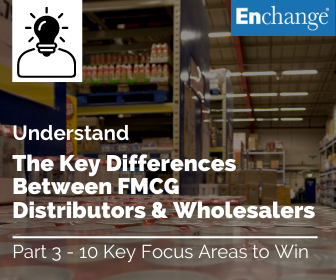This post is Part 3 of a series of posts discussing indirect distribution management, and specifically the characteristics and the key differences between FMCG Distributors and Wholesalers. You can read Part 1 which includes the Characteristics of Distributors here and Part 2 which includes the Characteristics of Wholesalers here.
Why are we spending time discussing FMCG Distributors and Wholesalers? Consider this:
- Distributors and Wholesalers are both key FMCG customers.
- Both are significant volume contributors.
- Both provide access to retailers and other customers.
- They have key differences, including goals, motivation, time horizons, resources, capacity, etc.
- They are often lumped together by FMCG management, creating an issue and potentially lost opportunities.

With the above in mind, what are the key areas to focus on or guidelines to remember when thinking about your Distributors and Wholesalers?
Distributor & Wholesale Management – 10 Key Focus Areas:
Approach
- Distributors are not necessarily ‘better’ than Wholesalers, they are just different, and for many FMCG companies both are often, essential.
Assigned Roles
- As we have discussed, Distributors and Wholesalers have different characteristics and, in many cases, they perform (sometimes subtly) different roles for the FMCG Co.
- You must determine for your organisation, the role each will play, as they will not be the same.
Customer Classification
- You must have clear classification criteria to determine what the differences are.
- It is less important what names are assigned to Distributors, Wholesalers, Traders, Cash & Carry’s, Sub Distributors, etc. Rather, it is of paramount importance that you understand their characteristics and assign them a classification to facilitate effective management.
Motivation
- What motivates a Distributor may have little impact on a Wholesaler. This needs to be identified and managed accordingly.
Management
- Very often Distributors are treated as key customers and managed accordingly, while Wholesalers are often forgotten. It is essential that Wholesalers are recognised as key customers.
- If you treat and manage Distributors and Wholesalers the same way, you will miss opportunities, and most likely cause commercial issues.
- A clear set of rules must be established on how they will be managed.
- It is essential that you should cover all the characteristics we have discussed previously (Agreements, Exclusivity, Management, Territories, Brand Range & SKUs, Remuneration, and Operations) when establishing any clear set of rules for the management of Distributors and Wholesalers.
Finally, let us consider some of the implications. Based on the characteristics that have been discussed in Part 1 & 2 of this blog series, a likely scenario is that the FMCG Co. has less influence over Wholesalers than Distributors. However, if the FMCG Co. has classified Wholesalers correctly, and has tailored their approach accordingly, they could, for example, design incentive packages for each classification.
This would provide Wholesalers the necessary motivation to deliver specific goals that have been identified by the FMCG Co. to be within their competency. This would allow the FMCG Co. to play to the Wholesaler’s individual strengths, rather than generating frustration from managing a Wholesaler the same as a Distributor. Far better results and sales would follow.
I hope this provides some guidance. If you need specific help, please reach out to me directly. Feel free to use our 20 Steps to Route to Market Excellence model to give you inspiration on your RtM journey.







